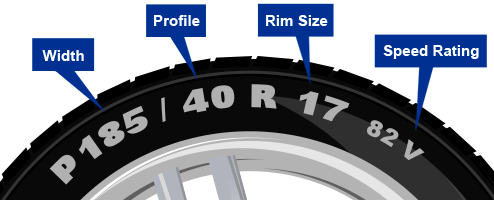Our Hor To Guide
Our guide is simple and straight forward

- Who makes the best tyres?
- How long should tyres last?
- How does tyre labelling work?
- How does tyre sizing work?
There are definitely several brands that are classed as ‘premium’
- Michelin
- Bridgestone
- Pirelli
- Goodyear
- Continental
- Dunlop
- Vredestein
However, it’s also about how much you’ve got to spend, and in many cases what type of car you’re driving. Tyre fitment can be vehicle specific, and picking the wrong ones could easily have a detrimental effect on your car’s handling. If in any doubt, check your servicing book to see which ones are recommended.
Some budget tyres perform surprisingly well in certain circumstances at the expense of other qualities, for example having brilliant dry grip but loads of road noise, so to bring it all together there’s now an industry-recognised labelling system for all new tyres.
How Long Do Tyres Last?
The answer to this question involves several variables since it depends not only on which tyres your car is using, but how you're driving, the condition of the roads you've used and how well you're looking after the tyres themselves.
However, for general driving, we'd expect you should be able to get 20000 miles from a set of four without much fuss. Obviously, that'll be far lower if you've got a supercar with expensive, sticky rubber, or an off-roader with chunky all-terrain tread.
How Tyre Labelling Works
The factors that are shown are:
- Fuel efficiency – this is the rolling resistance of the tyre, which has an effect on how much fuel your car uses. It’s listed on a sliding scale from A (best performer) to G (poorest fuel economy)
- Wet grip – simply put, tyres with better-wet grip have shorter braking distances in damp conditions. Again this is labelled A-G
- External noise – you get two ratings here: one for the level of noise the tyre makes measured in lab conditions and displayed in decibels, and one that shows one, two or three ‘soundwaves’ giving the rating context with other tyres
What It Stands For
- 205 – the width of the tyre in millimetres
- 45 – the tyre’s aspect ratio
- R – simply tells you what sort of tyre it is. In this case, and the vast majority of others, it’s Radial
- 17 – the diameter of the tyre, in inches this time
- 91 – the load index of the tyre, i.e. how much weight it can carry. In our example 91 equates to 615kg per tyre, which is more than enough for a large family car or caravan
- W – the tyre speed rating. In this case, it’s W or 168mph
Mobile Tyre Fitting > How To Guide in: How To Guide